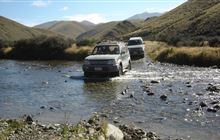Environmental Impact Assessment (EIA)
Introduction
If you undertake an activity on public conservation land you must provide an EIA with your application.It is DOC’s responsibility to conserve New Zealand’s natural and historic heritage for all to enjoy now and in the future.
Before each permit is granted we must consider the environmental effects of each proposed activity. This is largely done through the submission of an Environmental Impact Assessment (EIA).
Who needs to provide an EIA
Everyone applying to undertake an activity on public conservation land must provide an EIA with their application. The size and amount of detail in your EIA depends on the size and scale of your activity and its potential environmental effects.
The EIA is an integral part of each application, and helps to determine whether your permit is granted and what type of conditions and monitoring may be required.
What you should include in your EIA
No matter how large or small the proposal, an application for an EIA should:
- describe in detail your proposed activity
- detail the physical and social conservation values affected by your proposal
- identify the potential effects of the proposal, both positive and adverse
- describe any measures to avoid, remedy or mitigate adverse effects
- identify any alternative locations, times or designs that would mitigate the adverse effects of the proposal
- prescribe a programme to monitor any ongoing effects.
For low to medium impact activities the information requested (if completed fully) in the EIA section of the application form should be sufficient.
For a large scale activity with potentially significant effects then considerable detail will be needed and a separate EIA report is likely to be required. Use the Environmental Impact Assessment Guide below to help you.
Environmental Impact Assessment Guide
Our Guide to preparing your environmental impact assessment (PDF, 125K) can help you to fill out the EIA section of the application form, or complete a separate EIA report if required.
The guide contains six steps to help you complete your EIA as well as a tool for identifying the environmental effects of your proposed activity, and a checklist for mitigating these effects.
Low to medium impact activities
These are activities that are likely to have minimal environmental impacts. This includes activities such as:
- hunting and fishing
- short and overnight guided walks
- one off or irregular aircraft landing
- rafting or kayaking
- some filming
- some easements
- short term grazing
- small one off events
- long term grazing
- large, annual sporting events.
Large scale activities
These are activities that are likely to have more significant environmental impacts. This includes activities such as:
- the building of any structure
- low impact activities in sensitive locations
- large scale films
- telecommunication sites.
Contact us
Your pre-application meeting with DOC can help you scope out the environmental effects that you will need to consider. This will ensure that you do not spend extra time and money providing unnecessary information.
To arrange a pre-application meeting or talk to someone about your EIA if you are applying for a one-off concession (required for a period of no longer than three months) contact your local DOC office.
If your application is for a longer period see permit contacts for the best office to contact.



